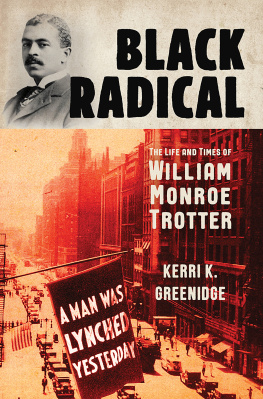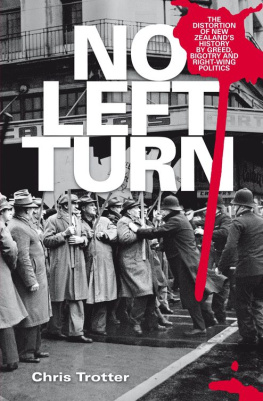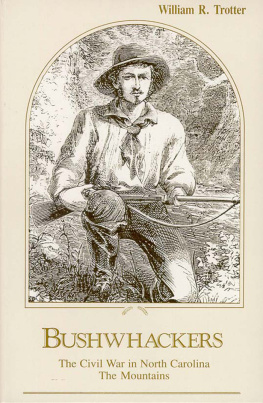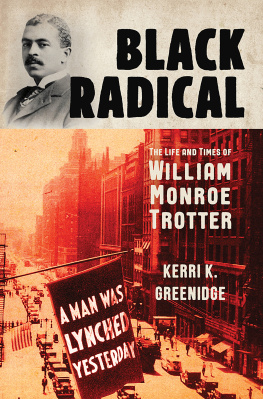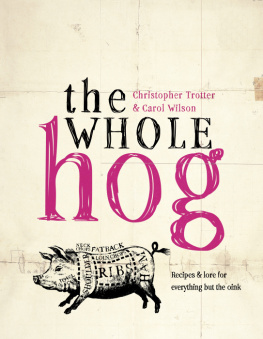

BLACK RADICAL

Black Radical

The Life and Times of
WILLIAM MONROE
TROTTER

KERRI K. GREENIDGE


LIVERIGHT PUBLISHING CORPORATION
A DIVISION OF W. W. Norton & Company
INDEPENDENT PUBLISHERS SINCE 1923
For Ariel Gertrude King Dance,
Samuel Lee Dance, Ariel Greenidge

S TANDING ON THE ROOF OF 41 CUNARD STREET IN LOWER Roxbury, William Monroe Trotter was struck by the changes to Boston in the six decades since his family first moved to the city. Before his April 1872 birth, when his newlywed parents settled briefly on Kendall Street a few blocks east of Cunard, Roxbury was a recently annexed addition to Boston proper that contained the last remnants of the Yankee elite, buttressed by working-class Irish and German immigrant tenement houses. Back then, the Boston and Providence Railroad tracks bound the area around Columbus Avenue and Tremont Street, while wet marsh land sustained a glimpse of what used to be Boston Neck, the thin sliver of land that connected the city proper to the agricultural lands of Roxbury town. Then, too, the brick, single-family houses and planned streets of the nearby South End were home to new money Protestants, and the black and brown faces that were so ubiquitous in Trotters time were rare. By 1934, however, the elevated railway, a bastion of Gilded Age innovation when it opened in 1901, towered over the bustling grocery stores, barbershops, and laundries along Tremont Street, from which a cacophony of urban noise punctuated the early morning air with the false promise of industry recently toppled by the Great Depression.
Looking northeast from Cunard Street toward Brigham Circle, Monroe Trotter remembered when the West End was the heart of black Amidst these reveries Monroe Trotter also recalled the sting of being called white nigger as he gazed southeast toward his long-ago childhood in Hyde Park; and he still felt the pain of living with a father who, proud and determined to claim for himself what the world would deny him, rarely understood the racial trauma so different from that of the Mississippi Delta and the Ohio River Valley from which hed come.
As the sun rose over Frederick Douglass Square in the east, however, what struck Monroe Trotter the most was how little race proscriptiona phrase used during his fathers timehad changed since he first published the Guardian in 1901. True, black Bostons numbers had grown exponentially since thenthe nearly eighteen thousand colored people, concentrated mostly in the South End on the border with Trotters Lower Roxbury apartment, were nearly double the number of black and brown people who lived in all of Massachusetts thirty years before. When Monroe Trotter was a child, this closely knit, yet ethnically and culturally diverse community accepted one black editors 1883 notion that colored was, in fact, the correct term to define them. Given that a tenth of black Bostons population was born in the Caribbean, Canada, or Cape Verde, the term negro seemed insufficient. After all, since the early nineteenth century, colored Bostonians described men as blond-haired and blue-eyed as Suriname-born inventor Jan Ernst Matzeliger, and those as dark-skinned as Charlestown Representative Edwin Garrison Walker. Throughout his life, Monroe Trotter continued to use the term colored, proudly insisting that it was the only term capable of encompassing all that black Boston representedthe southerners from Baltimore and Raleigh, the cosmopolites from Toronto, Halifax, and London, Cape Verdeans and Bahamians whose lilting accents reverberated through Cambridgeport and the South End.
From his rooftop, Monroe Trotter could still see the diversity of colored Boston beneath the hazy light of early morningthe Jamaicans, Bajans, and Bahamians who entered St. Cyprians Episcopal Church a few blocks away; the recent North Carolina and Virginia migrants packed into buildings originally designed for single families, now deteriorating under the weight of absentee landlords and municipal neglect. But colored Bostons size would never compete with the nearly half-million black men and women in Harlem and Philadelphia, nor would its exponential growth in the first quarter of the twentieth century translate into political power, as indicated by the dearth of colored lawmakers. When Trotter graduated from Harvard in 1895, black Boston sent at least one representative to the state legislature every year beginning in 1865; in 1934, no black representative in nearly fifteen years had helped to craft law in either the state house or city hall. And this lack of representation took its toll on the community. In a city where nearly a third of all people were unemployed, black Bostonians suffered from the same low wages and poor job security with which theyd been plagued since the first Roosevelt administration, what little capital they had in businesses and banks decimated by the 1929 Crash.
But what must have broken Monroe Trotters heart the most as he faced the damp New England morning was the loss of his beloved Guardian, the weekly newspaper of colored Boston, a fixture in the citys political and cultural landscape years before the Washington El opened at Dudley Station. Since November 1901, the four-page weekly (extended to eight as demand grew) appeared faithfully every Saturday morning, an institution as synonymous with Boston as William Lloyd Garrisons legendary abolitionist paper, the Liberator, a century before. And Trotter, always the self-righteous Bostonian, relished this connection, printing the Guardian in the same Tremont Row office from which Garrison workeda bust of the bespectacled, earnest white man atop his desk next to stacks of civil rights petitions and folders of correspondence with W. E. B. Du Bois, Kelly Miller, Ida B. Wells, and Madame C. J. Walker.
In the last year, however, as the Great Depression ravished Boston businesses, the Guardian finally succumbed to the slow, painful death toward which it had been falling over the past decade. That January, bankruptcy almost claimed the thirty-two-year-old paper, although
Indeed, in 1934 it was easy for the public to forget Monroe Trotter, particularly since the fundamental divisions between black radicals, moderates, and conservatives persisteddespite decades of Guardian editorials and Faneuil Hall protests. Worse still was continued failure of the American government to protect black citizens from potential lynchings and other forms of violence. All the despondent Trotter saw was the gray Boston skyline, and the collapse of the one thing for which hed sacrificed so muchhis inheritance, his job, his familyeven as all of the civil rights demands for which hed been publicly maligned were finally accepted as mainstream.
And so he jumped, stumbling first against the metal drain pipe, then crumbling, broken in body as he had recently been in mind, on the icy pavement three stories below. It was just before five-thirty in the morning on Saturday, April 7, 1934, the day that the
Next page
